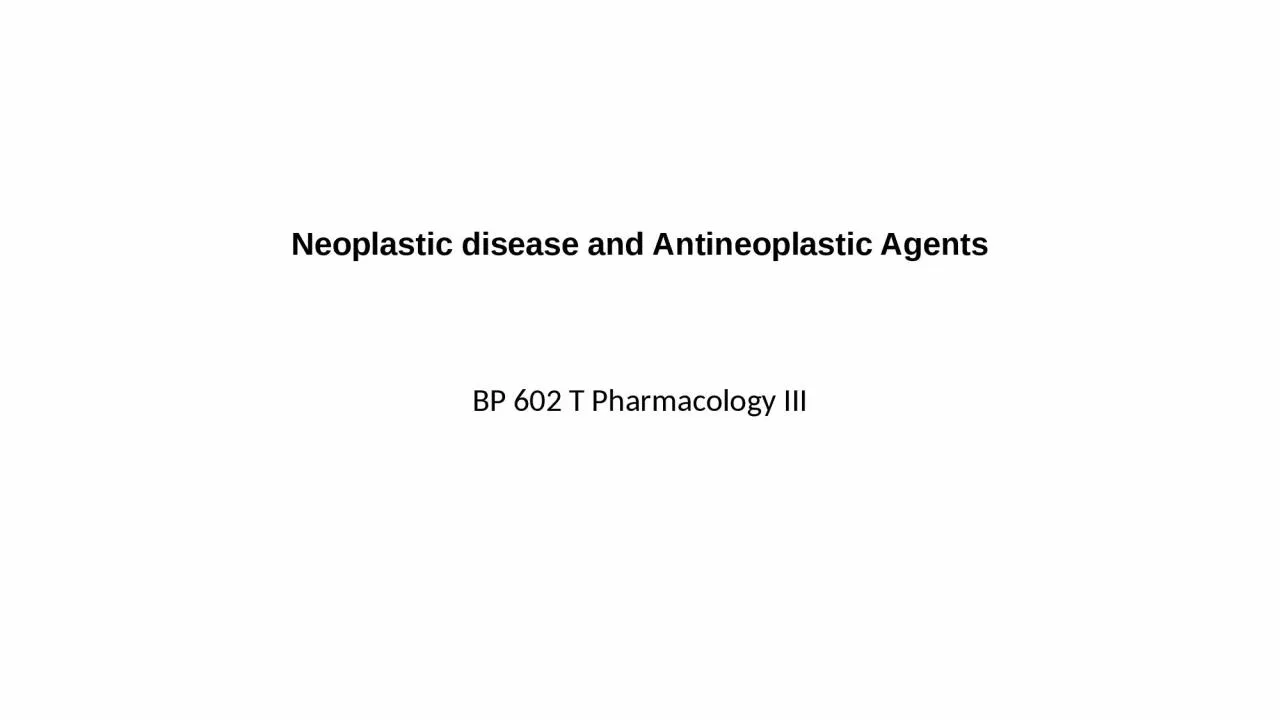

BP 602 T Pharmacology III Neoplastic disease Cancer is a disease characterised by uncontrolled multiplication and spread of abnormal forms of the bodys own cells The terms cancer malignant neoplasm ID: 914604
Download Presentation The PPT/PDF document "Neoplastic disease and Antineoplastic Ag..." is the property of its rightful owner. Permission is granted to download and print the materials on this web site for personal, non-commercial use only, and to display it on your personal computer provided you do not modify the materials and that you retain all copyright notices contained in the materials. By downloading content from our website, you accept the terms of this agreement.
Slide1
Neoplastic disease and Antineoplastic Agents
BP 602 T Pharmacology III
Slide2Neoplastic disease
Cancer is a disease
characterised
by uncontrolled multiplication and spread of abnormal forms of the body's own cells.
The terms
cancer
,
malignant neoplasm
(neoplasm simply means 'new growth') and
malignant
tumour
are synonymous.
Both
benign
and
malignant
tumours
manifest uncontrolled proliferation, but the latter are distinguished by their capacity for
dedifferentiation
, their
invasiveness
and their ability to
metastasise
(spread to other parts of the body).
Slide3Cancer treatment employs six established principal modalities:
Surgery;
Radiotherapy;
Chemotherapy;
Endocrine therapy;
Immunotherapy;
biological therapy.
Chemotherapy of cancer, as compared with that of bacterial disease, presents a difficult problem. In biochemical terms, micro- organisms are both quantitatively and qualitatively different from human cells, but cancer cells and normal cells are so similar in most respects
Slide4Rationale for cytotoxic chemotherapy
Modern cancer chemotherapy originated in the 1940s with the demonstration that nitrogen mustard [
with
sulphur
mustards
(oily vesicant liquids) which had been developed and used as chemical weapons in World War I (1914-18). Preparations for World War II (1939-45) included research to increase the potency and toxicity ('efficacy') of these odious substances. Substitution of a nitrogen atom for the
sulphur
atom, i.e. making
nitrogen mustards
The disappearance of lymphocytes and granulocytes from the blood of rabbits was a useful marker of toxicity and gave rise to the idea of possible efficacy in lymphoid cancers.
] possessed antitumor activity against human lymphomas and leukemias.
Other classes of cytotoxic agents, e.g.
antimetabolities
, were subsequently identified and used to treat cancer patients.
Slide5General Toxicological Properties of Anticancer Drug
Most of the Anti-cancer drugs
exert toxic effects on both normal and tumor tissues even at optimal dosages. This
lack of selective toxicity
is the major limiting factor in the chemotherapy of cancer. Rapidly proliferating normal tissues are the major sites of acute toxicity of these agents.
Bone Marrow Toxicity:
Maximum toxicity usually is observed 10 to 14 days after initiation of drug treatment, with recovery by 21 to 28 days.
Delayed wound healing
Mucosal Toxicity:
Like d
amage to the normally proliferating mucosa may produce
mouth ulcers/git ulcers,
Oral ulcerations, esophagitis, and proctitis may cause pain and bleeding due
to oral mucosal ulceration and intestinal denudation.
Hair Follicle Toxicity:
So produces partial or complete alopecia. Hair usually re-grows normally within
2-6 months
after completion of chemotherapy.
Germ cells and reproduction:
sterility may
occure
, most cytotoxic drugs are teratogenic and mutagenic.
Nausea and vomiting:
This is common, can be extremely severe and prolonged and cause patients to refuse treatment.
Slide6Classes of cytotoxic chemotherapy drugs
/ Classification
The classification can be done on several basis by adding recent agents for example
Cell cycle (phase) specific
Like G1, S, G2 and M specific
OR
Alkylating agents
By incorporating subclasses
Antimetabolites
Including subclasses like folic acid , pyrimidine like
analoges
with examples
Natural and semi-synthetic products
Different agents of natural origin
from plant kingdom and antibiotics
Hormones and antagonists
As were there in previous semester
Miscellaneous agents
Which are not truly falling in above specific classes
Slide7Summary of the mechanisms and sites of action of some chemotherapeutic agents useful in neoplastic disease.
PALA =
N
-
phosphonoacetyl
-L-aspartate; TMP = thymidine monophosphate.